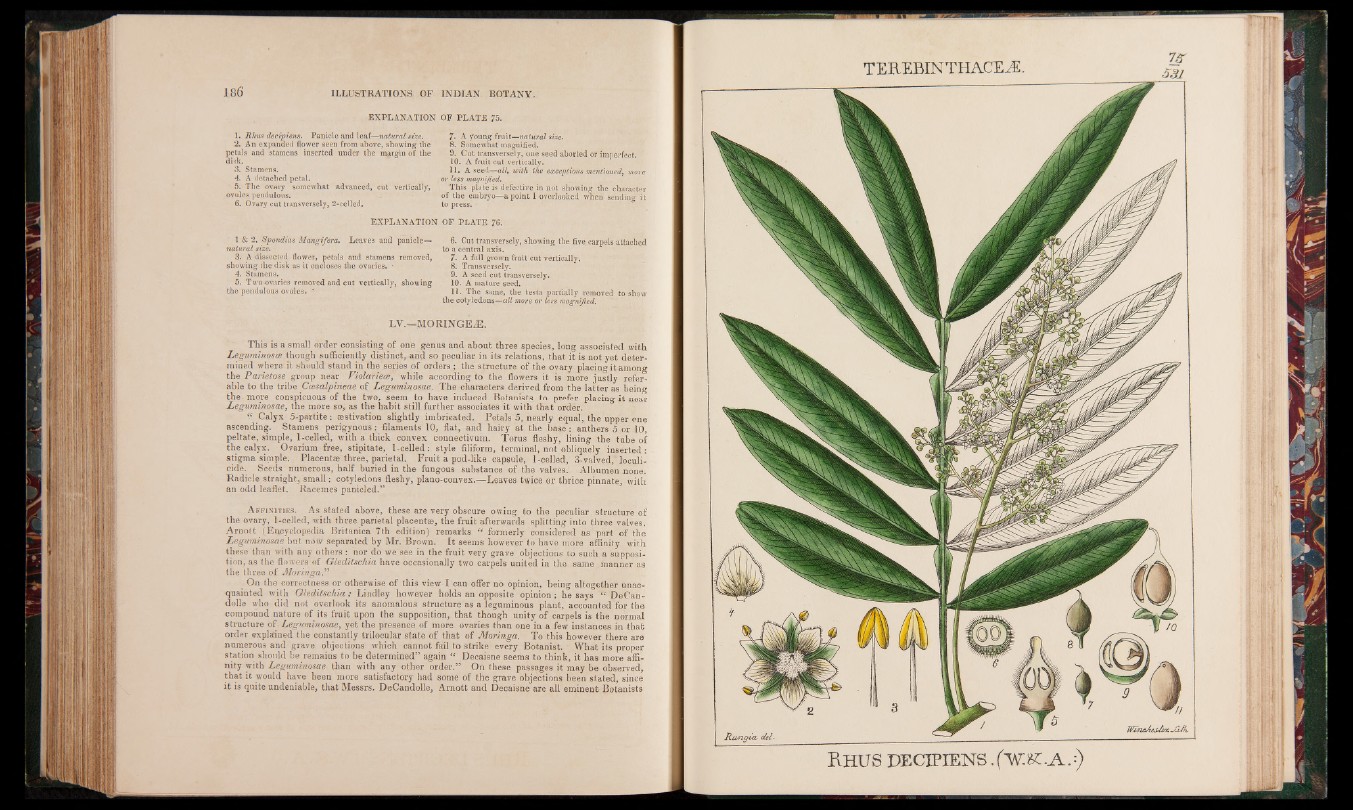
EXPLANATION OF PLATE 75.
7. A young fruit—natural size.
8. Somewhat magnified.
9. Cut transversely, one seed aborted or imperfect.
10. A fruit cut vertically.
11. A seed—all, with the exceptions mentioned, more
or less magnified.
This plate is defective in not showing the character
of the embryo—a point I overlooked when" sending it
to press.
1. Rhus decipiens. Panicle and leaf—natural size.
2. An expanded flower seen from above, showing the
petals and stamens inserted under the margin of the
disk.
3. Stamens.
4. A detached petal.
5. The ovary somewhat advanced, • cut vertically,
ovules pendulous.
6. Ovary cut transversely, 2-celled.
EXPLANATION OF PLATE 76.
1 & 2. Spondias Marigifera. Leaves and panicle— 6. Cut transversely, showing the five carpels attached
natural size. to a central axis.
3. A dissected flower, petals and stamens removed, 7. A full grown fruit cut vertically,
showing the disk as it encloses the ovaries. • 8. Transversely.
4. Stamens. 9. A seed cut transversely.
5. Two ovaries removed and cut vertically, showing 10. A mature seed.
the pendulous ovules. ■ 11. The same, the testa partially removed to show
the cotyledons—all more or less magnified.
LV.—MORINGEJ3.
This is a small order consisting of one genus and about three species, long associated with
Leguminosce though sufficiently distinct, and so peculiar in its relations, that it is not yet determined
where it should stand in the series of orders; the structure of the ovary placing it among
the Parietose group near Violafiece, while according to the flowers it is more justly referable
to the tribe Ccesalpineae of Leguminosae. The-characters derived from the latter as being
the more conspicuous of the two, seem to have induced Botanists to prefer placing it near
L eguminosae, the more so, as the habit still further associates it with that order.
“ Calyx 5-partite: aestivation slightly imbricated. Petals 5, nearly equal, the upper one
ascending. Stamens perigynous: filaments 10, flat, and hairy at the base: anthers 5 or 10
peltate, simple, 1-celled, with a thick convex connectivum. Torus fleshy, lining the tube of
the calyx. Ovarium free, stipitate, 1-celled: style filiform, terminal, not obliquely inserted:
stigma simple. Placentae three, parietal. Fruit a pod-like capsule, 1-celled, 3-valved, loculi-
cide. Seeds numerous, half buried in the fungous substance of the valves. Albumen none.
Radicle straight, small: cotyledons fleshy, plano-convex.—Leaves twice or thrice pinnate, with
an odd leaflet. Racemes panicled.”
Affinities. As stated above, these are very obscure owing to the peculiar structure of
the ovary, l-celled, with three parietal placentae, the fruit afterwards splitting into three valves.
Arnott (Encyclopedia Britanica 7th edition) remarks gj formerly considered as part of the
L eguminosae but now separated by Mr. Brown. It seems however to have more affinity with
these than with any others: nor do we see in the fruit very grave objections to such a supposition,
as the flowers of G leditschia have occasionally two carpels united in the same manner as
the three of M o r in g a .”
On the correctness or otherwise of this view I can offer no opinion, being altogether unacquainted
with G led its ch ia ; Lindley however holds an opposite opinion; he says “ DeCan-
dolle who did not overlook its anomalous structure as a leguminous plant, accounted for the
compound nature of its fruit upon the supposition, that though unity of carpels is the normal
structure of Leguminosae, yet the presence of more ovaries than one in a few instances in that
order explained the constantly trilocular state of that of M o rin g a . To this however there are
numerous and grave objections which cannot fail to strike every Botanist. What its proper
station should be remains to be determined” again “ Decaisne seems to think, it has more affinity
with Leguminosae than with any other order.” On these passages it may be observed,
that it -would have been more satisfactory had some of the grave objections been stated, since
it is quite undeniable, that Messrs. DeCandolle, Arnott and Decaisne are all eminent Botanists
TEREBINTHACEÆ.
R h u s d e c i p i e n s .(w .&.a .-)